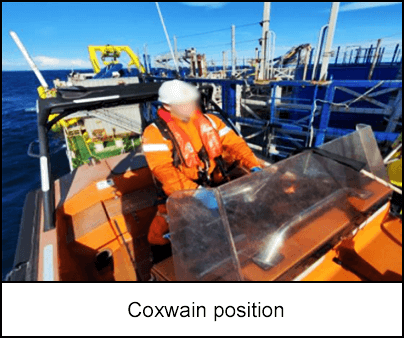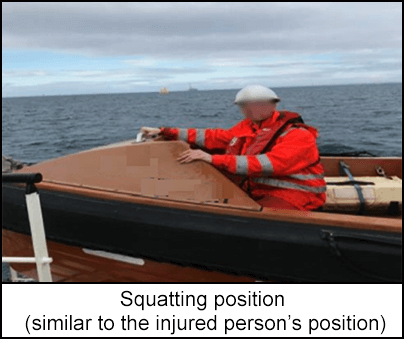-
What happened?
A fast rescue craft (FRC) launch and recovery drill was being performed, with 3 crew members assigned to the boat.
The FRC was lowered into the water with assistance from the ‘mother ship’ crew members.
The sail route commenced with reduced speed. After sailing around the stern of the mother ship, the coxswain increased speed.
The FRC unexpectedly hit larger waves, which caused it to bounce of the waves twice.
One of the crew members who was in a squat position at the front of the FRC was lifted off his feet twice in quick succession.
The combined impact of him falling and the boat hitting the water caused his leg to collapse and buckle beneath him.

-
Why did it happen?
Unsafe positioning due to lack of risk perception - injured person squatted at front of FRC.
Waves were larger than originally anticipated – the readings were carried out on the windward side of the mother ship.
The combination of increased speed and larger waves caused the boat to bounce on the waves twice.
Insufficient communication between crew members - the drill should have been better planned.

-
What did they learn?
Ensure everyone in the FRC is seated properly.
Mind your speed! Add signage near the helmsman and on the FRC launch and recovery system as a reminder.
Create specific vessel job safety analysis (JSA) for FRC operations to ensure the key risks and controls are communicated and understood.
Discuss the key activities associated with FRC operations during toolbox talks.
Carry out training sessions to ensure crew members are up to date with any revisions of the FRC operations manual, and with lessons learned from previous incidents.
Revise vessel procedure to improve guidance for FRC preparations and operations based on lessons learned from other incidents.
Update procedures to restrict the launch of emergency or small daughter craft within site boundaries.

-
Ask yourself or your crew
How do you correctly position yourself in a fast rescue craft?
What’s the best location for carrying out readings before launching a rescue craft? What difference does it make?
How is the crew onboard a rescue craft communicating with the mother ship in case of unstable sailing? Is there a better way?
What procedures do we have in place for FRC operations? How can we improve these to make our work safer?

Add to homescreen
Content name
Select existing category:
Content name
New collection
Edit collection
What happened?
A fast rescue craft (FRC) launch and recovery drill was being performed, with 3 crew members assigned to the boat.
The FRC was lowered into the water with assistance from the ‘mother ship’ crew members.
The sail route commenced with reduced speed. After sailing around the stern of the mother ship, the coxswain increased speed.
The FRC unexpectedly hit larger waves, which caused it to bounce of the waves twice.
One of the crew members who was in a squat position at the front of the FRC was lifted off his feet twice in quick succession.
The combined impact of him falling and the boat hitting the water caused his leg to collapse and buckle beneath him.

Why did it happen?
Unsafe positioning due to lack of risk perception - injured person squatted at front of FRC.
Waves were larger than originally anticipated – the readings were carried out on the windward side of the mother ship.
The combination of increased speed and larger waves caused the boat to bounce on the waves twice.
Insufficient communication between crew members - the drill should have been better planned.

What did they learn?
Ensure everyone in the FRC is seated properly.
Mind your speed! Add signage near the helmsman and on the FRC launch and recovery system as a reminder.
Create specific vessel job safety analysis (JSA) for FRC operations to ensure the key risks and controls are communicated and understood.
Discuss the key activities associated with FRC operations during toolbox talks.
Carry out training sessions to ensure crew members are up to date with any revisions of the FRC operations manual, and with lessons learned from previous incidents.
Revise vessel procedure to improve guidance for FRC preparations and operations based on lessons learned from other incidents.
Update procedures to restrict the launch of emergency or small daughter craft within site boundaries.
Ask yourself or your crew
How do you correctly position yourself in a fast rescue craft?
What’s the best location for carrying out readings before launching a rescue craft? What difference does it make?
How is the crew onboard a rescue craft communicating with the mother ship in case of unstable sailing? Is there a better way?
What procedures do we have in place for FRC operations? How can we improve these to make our work safer?
A fast rescue craft (FRC) launch and recovery drill was being performed. The FRC unexpectedly hit larger waves, which caused it to bounce of the waves twice. One crew man received serious injuries due to the impact.










